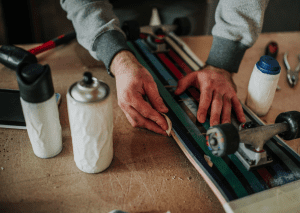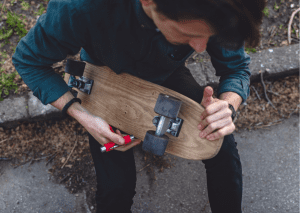
Skateboard enthusiasts all know the joy of cruising down the street on a well-tuned board. Riding a skateboard is exhilarating, but caring for your board takes effort.
In this skateboard guide, we’ll offer tips for caring for your skateboard:
- Cleaning your skateboard daily
- Checking for skateboard damage
- Replacing skateboard parts
- Tightening skateboard bearings
- Proper skateboard storage
- Caring for skateboard accessories
Our blog provides comprehensive guides on choosing the right accessories and gear for your skateboard, helping you keep it in top condition by ordering the best hardware and knowing how to remove and replace parts before shipping.
With this, you can ensure your ride remains smooth and safe whenever you hit the pavement. After all, taking care of our skateboard is one of the ways we serve ourselves and others; a well-maintained board means safer rides for us and less risk for those around us, too. So, let’s get started – here’s how to keep your board in peak condition daily!
Key Takeaways
Maintaining your board is not just beneficial for optimal performance; it’s essential for safety. Our guide provides comprehensive insights on essential maintenance practices, including cleaning, inspecting for damage, replacing worn parts, and ensuring proper storage. It’s important to routinely check components like wheels, trucks, and decks for signs of wear or damage and address these issues promptly to ensure safety and extend the lifespan of your board.
It is also crucial to care for your gear and accessories, particularly shoes, which can be worn unevenly depending on your skating style. We encourage embracing maintenance as a crucial part of your skateboarding passion. A clean and well-maintained board provides smoother rides and reduces risks, benefiting everyone in the skateboarding community.
When you order new accessories for your skateboard, always choose the best gear to keep it in top condition, and check our blog for the latest tips on hardware maintenance before shipping.
Lastly, never underestimate the importance of safety gear, such as wrist guards, which provide extra protection and help you enjoy a worry-free ride. By adhering to these practices, you ensure that you and your board are always ready for any skate session, keeping the thrill of skateboarding alive while ensuring your equipment remains in prime condition.
Clean Your Skateboard Deck Daily
This article covers how vital it is to keep your skateboard and its accessories in top shape – which is why we believe regular cleaning should be seen as part of our commitment to our passion for skateboarding. We can help you master the process of cleaning your deck and grip tape to ensure optimum performance and prevent premature wear.
After a long day of skating, use a towel and hot water to clean your wheels and remove any debris, then remove the bearings and wash them with dish soap for a thorough clean.
Another important task to check for is any damage on the skateboard, so make sure to do this regularly. Remember that cleaning and checking for damage are essential to a great skating experience.
Check Your Skateboard For Damage
It is important to inspect your skateboard for any potential damage. Doing so could save you a lot of trouble down the line. In particular, check your wheels and trucks for wear and tear.
- Inspect Regularly: It is important to inspect your skateboard regularly for any potential damage. This can save you a lot of trouble down the line.
- Focus Areas: Pay particular attention to your skateboard wheels and skateboard trucks for signs of wear and tear.
- Signs of Wear and Tear:
-
- Address Issues: If you spot any damaged or worn-out parts, take the necessary steps to fix them. This includes replacing your skateboard wheels, bearings, and decks.
- Routine Maintenance: Spending time on routine skateboard care practices will keep your board in good condition and prolong its life.
- Prevention Benefits: Regular inspections of your skateboards can save you time and money in the long run by preventing major issues.
- Safety Tip: Wearing wrist guards when skateboarding can add an extra layer of safety.
- To keep your skateboard in top shape, remove any damaged hardware and order replacement accessories from our blog recommendations, ensuring you choose quality gear that can withstand the rigors of shipping.
This checklist will help ensure that your board remains in optimal condition, enhancing both performance and safety. Regular inspections and maintenance save time and money in the long run and support a safer skating environment.
Replace Old Parts
Replacing worn-out parts as soon as you spot them is essential to ensure a smooth ride. Remove the bearings and other worn-out parts to prevent further damage that may cost more in the long run. Skateboard part longevity is crucial, and various upgrade options, like new kingpin nuts, can help enhance performance whether you prefer softer wheels or not. No one likes loose trucks, especially when riding on rough surfaces. You can use a razor blade for grip tape that isn’t securely attached. You want your deck to have a stable, flat surface.
Remember, down to the truck, each new component delivers an optimal and great experience. Let’s discuss maintaining your bearings for continual excellence and a smoother ride on your new board.

Maintenance is key when it comes to bearings and front wheels. Cleaning and lubricating the bearings and checking for signs of wear and tear are essential for increasing bearing longevity. Additionally, the type of bearings you use can also affect performance, so be sure to check the wheel, bearing, and axle nuts to ensure they are appropriate for your board. Make sure your wheels spin freely so you can ride your skateboard properly.
Doing so will ensure a more enjoyable ride and can help prevent potential damage for beginners and experienced skateboarders. Overall, replacing worn-out parts of skateboards is an important part of maintenance. We hope this information helps you to maintain your skateboard and keep it in great shape.
For the best skateboard accessories, always choose reliable sources to order from, ensuring your gear remains in top condition and arrives safely through careful shipping practices; check our blog for tips on maintaining your hardware and how to remove worn-out parts.
Maintain Skateboard Bearings
Maintaining the bearings on a skateboard requires regular attention, and this routine can significantly impact the overall performance and lifespan of your board, whether you like using larger or smaller wheels. We’re here to give you tips and tricks on maintaining your skateboard bearings and new wheels for optimal glide. With proper bearing selection and lubrication techniques, we can help our boards glide effortlessly.
To ensure smooth rides, extract the bearings from your skateboard and clean them with hot, soapy water, then dry them with a hair dryer and wipe them down with a paper towel.
Let’s ensure our board’s bearings are always clean, well-lubricated, and free from rust or debris. Many skateboarders use compressed air to keep their bearings clean. Now, let’s move to another crucial aspect of board maintenance – adjusting your trucks for the perfect balance and maneuverability.
Adjust Trucks With A Skateboard Tool
Nothing compares to the exhilaration of nailing a tricky maneuver, and getting your trucks adjusted just right can make all the difference. Understanding bushings, truck tightening techniques, and other components is crucial for optimal performance. For more tips, you can check out street skateboarding videos online.
Whether you’re looking for a new board or need to maintain the one you already have, our resources can help. We’ll discuss the different parts of skateboards, such as decks, trucks, and wheels, and the different skateboard styles, like street, park, and vert skateboarding.
Remember, it’s not just about stunts; it’s about caring for your gear, too. Properly storing your board can prolong its life and help sharpen your skills. Next, let’s talk about adjusting your trucks for a better ride.
Proper Skateboard Storage
Whether you’re a casual skateboarder or enjoy joining skating competitions, storing skateboards properly is essential to order and maintenance. It extends its life and ensures you’re always ready to take on the streets and parks. To ensure your skateboard is properly stored, opt for skateboard storage solutions such as racks or hooks that keep your deck off the ground and away from moisture.

Lastly, don’t forget the importance of protective gear, as it serves us and the skateboarding community as a whole. We hope this article has helped teach you how to store skateboards properly.
Conclusion
Maintaining your board is essential for enhancing your ride and ensuring your safety and the longevity of your equipment. Choose and remember to clean your wheels using hot water and dish soap when maintaining your skateboard, then extract the bearings and dry them with a paper towel and a hair dryer for optimal performance.
You can keep your board in excellent condition by following the detailed guide, which covers everything from regular cleaning, checking for damage, and replacing parts to properly storing and caring for accessories. This dedication to upkeep ensures order, smoother and safer rides and helps cultivate a culture of responsibility among riders. Remember, a well-kept board is your best ally on the road, allowing you to perform optimally while minimizing risks for you and those around you. So, embrace these practices and ride with confidence and assurance.
We’ve covered a lot in this guide, from cleaning and inspecting for damage to updating parts, caring for bearings, adjusting trucks, and correctly storing your equipment—all essential tips for keeping your board in prime shape. Riding requires special care, so let’s ensure our equipment is properly maintained. If maintaining maintenance has been a challenge, consider this your motivational boost!
Happy skateboarding!
Frequently Asked Questions (FAQs):
How Do You Maintain Your Deck?
Deck maintenance involves regular cleaning, inspection, and maintenance of all components, such as the wheels. This includes checking for wear and tear with a skate tool, cleaning dirty bearings, tightening or replacing the axle nut and kingpin nut as needed, checking the grip tape, and keeping your skateboards dry and safely stored. A clean board can improve your skateboard instruction experience even if you’re starting out.
How Often Should I Be Cleaning My Board?
The general rule is to clean your boards every few weeks or more frequently, depending on usage. If you ride them regularly or are riding on dirty or rough patches, a weekly cleaning might be necessary, with more effort needed to clean bearings. A regularly maintained board makes for a great riding experience.
How Do You Not Ruin A Skateboard?
Don’t ride skateboards in wet or extremely harsh conditions to avoid ruining skateboards. Also, avoid overloading them, which can lead to a break or a razor tail, and tighten all the components, like the axles, nuts, and bolts, with the proper tools without overdoing it. Overtightening to the point where you struggle to loosen the components can lead to damage.
How Do I Protect My Deck?
You can protect your deck by using new grip tape for more grip, backing paper, or a deck protector, avoiding riding in wet conditions, and storing it in a dry, temperature-controlled environment. Regularly inspect for cracks and replace the deck if necessary, using a utility knife for grip tape replacement if needed. Regular cleaning helps remove dirt and keep it from building up. Follow the advice and best tips of your skateboarding instructor. When preparing your skateboard for shipping, remove all detachable hardware and pack your accessories carefully; our blog has useful advice on ordering the right gear and choosing the best packing methods to keep everything in top condition.
Do I Need To Oil My Bearings?
Yes, you need to oil the ball bearings of skateboards to ensure they roll and spin smoothly. However, specialized bearing oil for skateboards, like lube, should be used, not just oil. Make sure a few drops get into the ball bearings inside. You can find bearing oil at your local skate shop.
Is It OK To Ride When It’s Wet?
Skateboarding when wet is not recommended, as the water can warp your deck and rust your bearings and hardware like the truck axle. Additionally, it reduces traction on smooth surfaces, increasing the risk of accidents. Always keep your skateboard dry; wipe it down and let it air dry if it gets wet.
What Not To Do When Riding?
When skateboarding, always wear protective gear. Most skaters don’t ignore their skill level or try to perform tricks beyond it without proper training, and you should do the same. Also, skateboarding should be avoided in crowded or inappropriate areas. If you’re a beginner, you might want to consider taking summer camp skateboard lessons or a professional private instructor as you develop your riding style.
How Many Years Do Decks Last?
The lifespan of skateboards largely depends on usage, quality, and proper skateboard maintenance, but on average, skateboards can last between 1 to 5 years. Skaters who use their skateboards heavily or encounter flat spots might need to replace parts or the entire board more often.
How Can I Make My Board Last Longer?
You can protect your deck by using new grip tape for more grip, backing paper, or a deck protector, avoiding riding in wet conditions, and storing it in a dry, temperature-controlled environment. Regularly inspect for cracks and replace the deck if necessary, using a utility knife for grip tape replacement if needed. Regular cleaning helps remove dirt and keep it from building up. Also, remember to clean your wheels regularly to ensure optimal performance. Follow the advice and best tips of your skateboarding instructor.
How Do You Oil A Board?
Yes, you need to oil the ball bearings of skateboards to ensure they roll and spin smoothly. However, specialized bearing oil for skateboards, like lube, should be used, not just oil. Make sure a few drops get into the ball bearings inside. Additionally, clean your wheels with dish soap to keep your skateboard in top condition. You can find bearing oil at your local skate shop.
DISCLAIMER (IMPORTANT): This information (including all text, images, audio, or other formats on FamilyHype.com) is not intended to be a substitute for informed professional advice, diagnosis, endorsement or treatment. You should not take any action or avoid taking action without consulting a qualified professional. Always seek the advice of your physician or other qualified health provider with any questions about medical conditions. Do not disregard professional medical advice or delay seeking advice or treatment because of something you have read here a FamilyHype.com.